
Station Name: FOULRIDGE[Source: Alan Young]
Foulridge Station Gallery 1: 1889 - July 1968 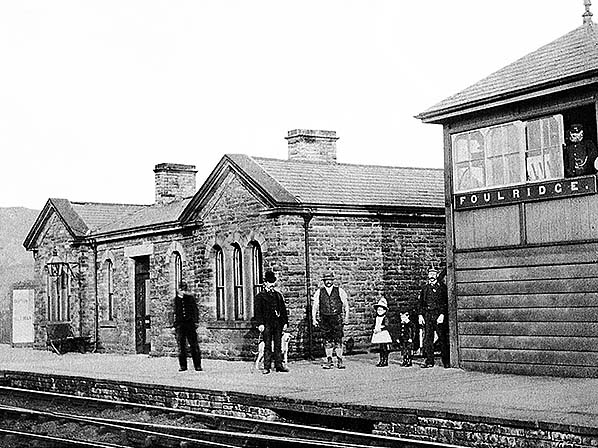 The down platform at Foulridge station, looking east in 1889. The single-storey sandstone building has a modest dignity, and today it can be enjoyed, rebuilt at Ingrow West station on the Worth Valley Railway. The signal box is on the right, with the signalman distracted from his duties.
Photo from late Donald Binns collection  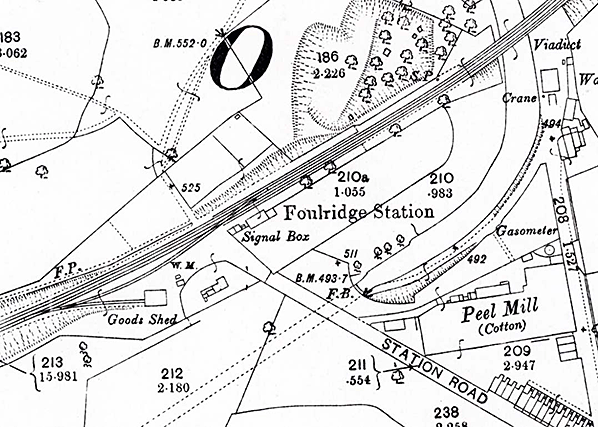 1894 1: 2,500 OS map. The ‘Foulridge Gap’ provides the least challenging crossing of the Pennines between Lancashire and Yorkshire and was followed by road, rail and canal. Here the proximity of railway and canal can be seen, the latter emerging from its 1,640yd tunnel at ‘FB’ (footbridge). The main building and signal box are on the down (south-east) platform of Foulridge station, but at this time no building is shown on the opposite side of the line. The goods facilities are on the down side, south-west of the passenger station, and they consist of a loop and short siding into the goods shed. ‘WM’ indicates the weighing machine in the coal yard. Station Road is a cul-de-sac, and the village lies south and east of the area shown on this map extract. 1894 1: 2,500 OS map. The ‘Foulridge Gap’ provides the least challenging crossing of the Pennines between Lancashire and Yorkshire and was followed by road, rail and canal. Here the proximity of railway and canal can be seen, the latter emerging from its 1,640yd tunnel at ‘FB’ (footbridge). The main building and signal box are on the down (south-east) platform of Foulridge station, but at this time no building is shown on the opposite side of the line. The goods facilities are on the down side, south-west of the passenger station, and they consist of a loop and short siding into the goods shed. ‘WM’ indicates the weighing machine in the coal yard. Station Road is a cul-de-sac, and the village lies south and east of the area shown on this map extract.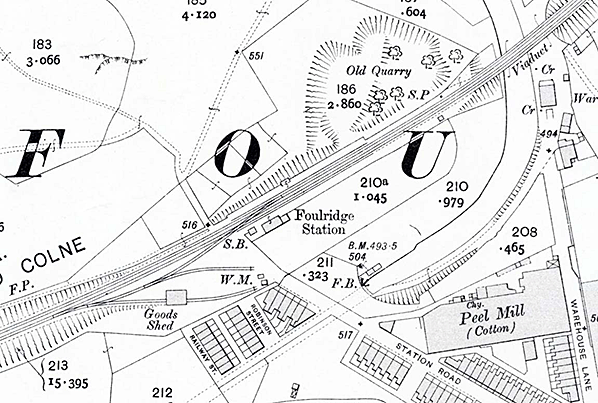
1912 1: 2,500 OS map. The village has expanded north-westwards to the station since the earlier map. A passenger shelter has been built on the up platform. In the goods yard a further siding has been added and the existing siding has been extended beyond the goods shed.
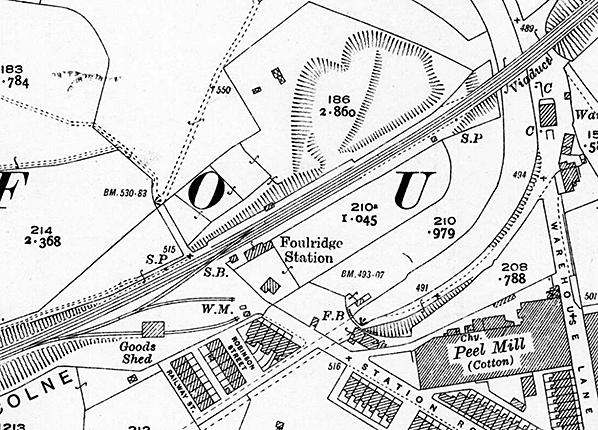 1932 1: 2,500 OS map. The railway has continued to limit the expansion of the village; in the 21st century the village still stops here. The goods facilities appear unchanged since the map of 1912.
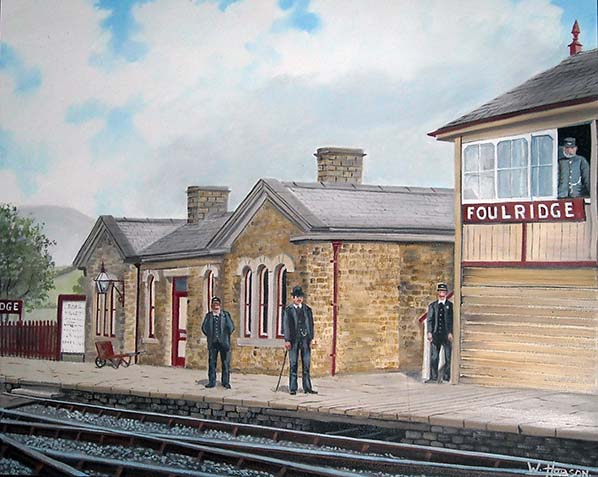
A painting by Billy Hobson based on the 1889 photo of Foulridge station.
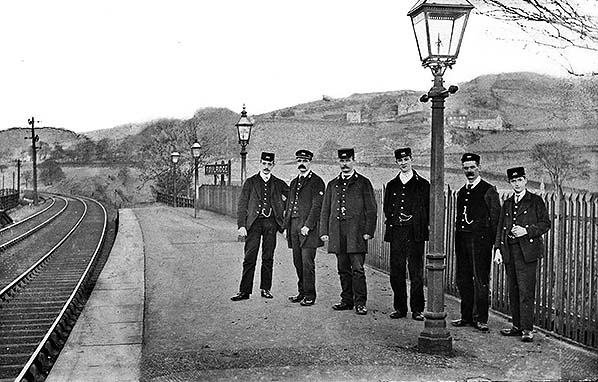
Station staff stand smartly attired on the down platform at Foulridge on a date before November 1904. The view is north-eastward. The series of fine Midland Railway lamp standards with their elegant gas lantern cases can be admired, as can the MR nameboard, of the distinctive double style – two boards, conjoined and set at an angle to each other to make them more readily legible from passing trains.
Copyright photo from John Alsop collection 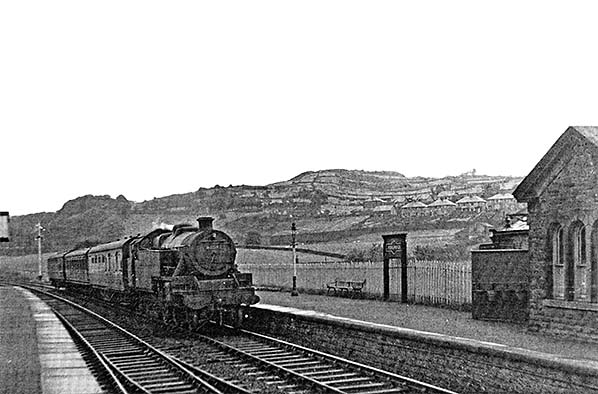
Foulridge station looking north-east from the up platform on 5 June 1952. A three-coach stopping service is drawing into the station hauled by No.42549 2-6-4T. On the down platform the main building is seen far right, together with an LMS ‘Hawkseye’ nameboard and an LMS gas lantern mounted on what is probably an MR post. The awning of the up platform waiting shelter creeps into the photo, far left. The loco is a Stanier-designed Class 4 built in July 1936 by the North British Locomotive Company, Glasgow. She would be withdrawn in November 1961 from 26A, Newton Heath shed and cut
up at Crewe works. 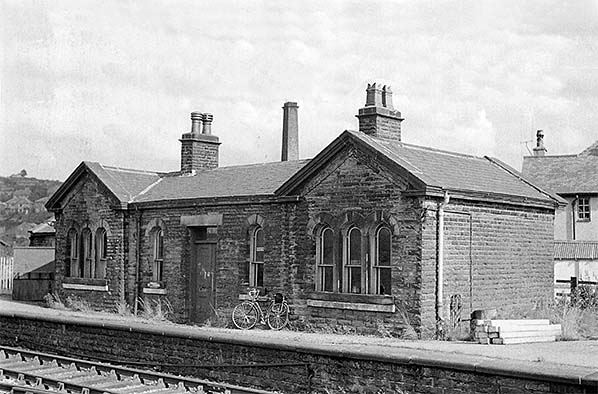 The main building at Foulridge station, on the down platform, looking east in the mid 1960s. The station closed to all traffic in January 1959 but the railway remained in use until February 1970.
Photo by G Tonks from late Donald Binns collection 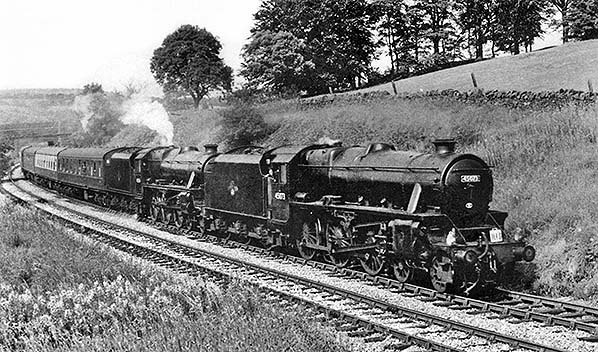
On the afternoon of 28 Jul 1968 the Severn Valley Railway Society and Manchester Rail Travel Society ‘Farewell to BR steam’ railtour is seen southbound between Foulridge and Colne. Originating at Birmingham New Street and travelling as far as Carnforth the tour included the Tyldesley Loop, to close to passengers in 1969 as well as the threatened Colne Branch. On this leg of the journey the train is hauled by Nos.45073 and 45156 ‘Ayrshire Yeomanry’. No 45073 is a Stanier-designed ‘Black Five’ 4-6-0 built in June 1935 at the LMS Crewe works. She was withdrawn from 24C, Lostock Hall shed, in August 1968 and Drapers, Neptune Street Goods Yard, Hull disposed of the locomotive in March 1969. No.45156, also a ‘Black Five’, was built by Armstrong Whitworth, Newcastle upon Tyne, in July 1935. She was withdrawn from 24B, Rose Grove shed, in August 1968 and T W Ward, Beighton, Sheffield disposed of the loco the following December.
Photo by G W Morrison Click here for Foulridge Station Gallery 2:
|
 The station had two facing platforms and the principal building was on the down (south-east) side. This was a neat, self-assured structure built of sandstone. The single-storey twin-pavilion design was mildly Classical in style, the overhanging gables having something of the appearance of broken pediments. The pavilions each had triple, round-headed window openings, and the rectangular, central door opening was flanked by single round-headed windows. The signal box stood immediately south-west of the station building. On the up platform was a timber pitched-roofed waiting shed supporting a small, flat awning with a deep valance.
The station had two facing platforms and the principal building was on the down (south-east) side. This was a neat, self-assured structure built of sandstone. The single-storey twin-pavilion design was mildly Classical in style, the overhanging gables having something of the appearance of broken pediments. The pavilions each had triple, round-headed window openings, and the rectangular, central door opening was flanked by single round-headed windows. The signal box stood immediately south-west of the station building. On the up platform was a timber pitched-roofed waiting shed supporting a small, flat awning with a deep valance.
 In the inter-war years buses between Skipton and Colne, passing along the main road through Foulridge village, snatched traffic from the railway. Buses could convey passengers to and from the town centres whilst the railway stations were inconveniently placed; at Colne a steady uphill walk faced railway passengers bound for the town centre. A further self-inflicted weakness of the railway was that, even under unified LMS administration the traditional Midland and Lancashire & Yorkshire / London & North Western frontier at Colne persisted, with the LMS Midland and Central divisions having their interface at Colne, requiring passengers to change trains here if they intended to travel further.
In the inter-war years buses between Skipton and Colne, passing along the main road through Foulridge village, snatched traffic from the railway. Buses could convey passengers to and from the town centres whilst the railway stations were inconveniently placed; at Colne a steady uphill walk faced railway passengers bound for the town centre. A further self-inflicted weakness of the railway was that, even under unified LMS administration the traditional Midland and Lancashire & Yorkshire / London & North Western frontier at Colne persisted, with the LMS Midland and Central divisions having their interface at Colne, requiring passengers to change trains here if they intended to travel further.  After closure, Foulridge station remained intact for many years although by 1970 (when the line closed) the central part of the down platform had partially collapsed. In this year the rails were removed and the building on the up platform was demolished, but the down platform building remained in place. By 1983 the building was derelict and its windows boarded, but an interesting future awaited it. The Keighley & Worth Valley Railway, closed by BR in 1962, had reopened and was thriving as a ‘heritage’ railway, and this ex-Midland line possessed fine, original buildings at Keighley, Oakworth, Haworth and Oxenhope stations. However, at Ingrow West the building was of little merit, and the elegant, but decaying, Midland building at Foulridge was thought to be well suited to a new life in Yorkshire. So it was that in 1986 this building was carefully dismantled and conveyed to Ingrow where it was rebuilt and can be enjoyed today, albeit in the wrong county; in fairness, the Lancashire / West Riding boundary was under a mile north of Foulridge, as a roadside plaque on the A56 reminds us!
After closure, Foulridge station remained intact for many years although by 1970 (when the line closed) the central part of the down platform had partially collapsed. In this year the rails were removed and the building on the up platform was demolished, but the down platform building remained in place. By 1983 the building was derelict and its windows boarded, but an interesting future awaited it. The Keighley & Worth Valley Railway, closed by BR in 1962, had reopened and was thriving as a ‘heritage’ railway, and this ex-Midland line possessed fine, original buildings at Keighley, Oakworth, Haworth and Oxenhope stations. However, at Ingrow West the building was of little merit, and the elegant, but decaying, Midland building at Foulridge was thought to be well suited to a new life in Yorkshire. So it was that in 1986 this building was carefully dismantled and conveyed to Ingrow where it was rebuilt and can be enjoyed today, albeit in the wrong county; in fairness, the Lancashire / West Riding boundary was under a mile north of Foulridge, as a roadside plaque on the A56 reminds us!
 Home Page
Home Page